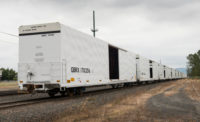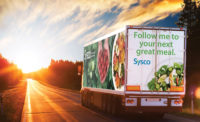Freight railroads keep America moving. From the food on our tables to the cars we drive to the shoes on our children’s feet, freight railroads carry the things America depends on, according to the Association of American Railroads (AAR), Washington, D.C.
“America’s railroads account for 40% of intercity freight volume—more than any other mode of transportation—and provide the most efficient and affordable freight service in the world,” says AAR. “Every year, America’s freight railroads save consumers billions of dollars while reducing energy consumption and pollution, lowering greenhouse gas emissions, cutting highway gridlock and reducing the high costs of highway construction and maintenance. In addition, America’s freight railroads sustain 1.2 million jobs, including more than 180,000 well-paying jobs in the freight rail industry itself.”
That’s why today’s rail providers, port authorities and boxcar manufacturers are teaming up to provide America with the most efficient and sustainable ways to transport goods from Point A to Point B.
Reducing emissions while maintaining efficiency
In order to keep today’s supply chains moving in a sustainable fashion, freight and railroad operators have introduced a number of state-of-the-art technologies that allow cold food processors and distribution warehouses the ability to reduce emissions while maintaining efficiency.
For example, Union Pacific built new 72-foot refrigerated boxcars that are equipped with GPS-monitoring software to remotely manage reefers from its Omaha, Neb., headquarters.
“We can view hundreds of data points relative to the location and function of these cars and can remotely troubleshoot issues from our desks,” says Nick Langel, senior business manager, agricultural products. “Powered by high-efficiency refrigerator units, these boxcars also feature a forced fiberglass liner filled with polyurethane pour foam for extra insulation and temperature readers. They are checked upon completion with an infrared camera to assure there are no voids in the insulation.”
Union Pacific also re-launched its refrigerated trailer-on-flat-car and container-on-flat-car products.
“This included upgrading our fueling options for carriers and looking at additional lanes of traffic that were not traditionally temperature-control friendly,” says Shane Blair, senior business director, intermodal. “In the past 21 months, we have gone from moving 200 intermodal loads per month to more than 6,000 loads per month.”
Additionally, Union Pacific can place 3-4 trucks’ worth of product in one refrigerated boxcar, which reduces emissions by three times when compared to trucks in a similar lane, says Langel.
“The benefit to customers is that they receive greater value for their transportation dollar along with a reduced carbon footprint,” adds Langel. “In 2013, the refrigerated boxcar shipments we handled for our customers reduced their overall carbon footprint collectively by 350,000 metric tons. That savings is equivalent to the carbon removed by more than 75,000 acres of U.S. forests.”
Florida East Coast Railway (FECR), Jacksonville, Fla., acquired 500 new 53-foot containers, 100 chassis and 50 refrigerated trailers that are equipped with GPS technology, providing real-time tracking capabilities.
“FECR’s refrigerated equipment has safeguards that are monitored 24/7 for temperature control,” says Robert Ledoux, senior vice president. “Necessary adjustments are made remotely via software, limiting the potential of human error in the process. FECR [also] maintains strict security protocols to protect all of our customers’ shipments. To that end, FECR has its own well-trained and skilled police force.”
Meanwhile, Maersk Line, Florham Park, N.J., upgraded its reefer unit microprocessor technology.
“This updated software continues to optimize reefer unit performance while improving energy consumption,” according to Barbara Pratt, director, reefer management. “We also have placed updated devices on many of our gensets to provide the information needed to further optimize their performance and improve their utilization/logistics.”
Riding the express lane
To transport product from California to Illinois via rail, McKay TransCold, Edina, Minn., launched TransCold Express, a hub-to-hub refrigerated boxcar service that runs bi-directionally between Wilmington, Ill., and Selma, Calif. Dubbed to be the first refrigerated boxcar unit train connecting the Midwest and West Coast in over half a century, TransCold Express presents produce growers and meat and dairy producers the opportunity to distribute products more cost-effectively to all U.S. destinations.
“It makes economic sense to ship over 800 miles via rail,” says Jason Spafford, vice president of business development. “In the McKay TransCold boxcar unit train, where heavier products can lead to four truckloads in one boxcar, there tend to be even more advantages for refrigerated and frozen products that are heavier.”
TransCold Express operates on BNSF Railway with cargo being transferred from truck to boxcar through a new refrigerated building operated by National Logistics and Cold Storage. It hauls products such as vegetables, fruit, cheese and butter from California to the Midwest and carries meat, eggs, cheese, butter, finished goods and dairy creamers westbound. The 49,000-square-foot refrigerated facility is approximately 700 feet long, allowing for eight boxcars to be unloaded at once, and only 70 feet wide, providing a minimal transfer distance between the two modes of transportation.
Meanwhile, the Port Authority of New York and New Jersey approved a re-development of the Greenville Yard to include a new ExpressRail facility to support the adjacent Global Marine Terminal. This will allow the terminal to ship and receive containerized cargo by rail, a capability that it lacks today. The new facility will also allow for transloading of containerized cargo from ship to rail, offering ocean carriers and their customers a more efficient and environmentally friendly option for moving goods. The facility will have an initial capacity of at least 125,000 cargo container lifts a year, and is expected to be operational in July 2016.
The board also approved a series of improvements to the cross-harbor car float system operated by NY-NJ Rail that moves freight more efficiently by both water and rail as opposed to truck between New Jersey and markets east of the Hudson River, including New York City and Long Island. The NY-NJ Rail operation allows freight to be loaded on rail cars, as the cars are moved by marine rail barge (carfloat) from Greenville to rail yards at 51st Street and 65th Street in Brooklyn, N.Y. When completed, the program will provide significant environmental benefits, including reductions to vehicle travel time, fuel consumption and a reduction in air emissions.
Regardless of the distance or type of cold food product, freight railroads keep America moving in a more efficient, sustainable and economical manner.







